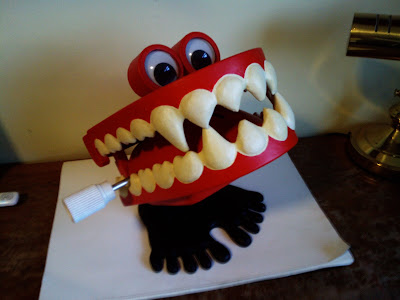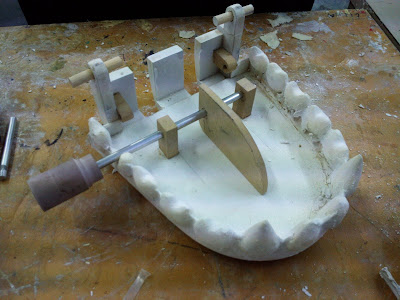
Tuesday, 7 December 2010
Tuesday, 30 November 2010
Open wide, say AHH...You may need some fillings...


 Vacu formed the tongue, made the handle ou of chemiwood on the Lathe-the wood spins while a blade controlled and angled by yourself cuts away at it.
Vacu formed the tongue, made the handle ou of chemiwood on the Lathe-the wood spins while a blade controlled and angled by yourself cuts away at it. Above shows the very simple mechanism for opening the mouth. The handle turns the piece of wood up out of the tongue through a slit, lifiting the top jaw up.
Now glued the polyfoam teeth on with a glue gun, began working into with pollyfilla-a wonderful thing. sanding and painting left and gluing on the eyes.
The light is at the end of the tunnel.
Friday, 26 November 2010
Thursday, 25 November 2010
Wednesday, 24 November 2010
Could you pass me another clamp?
Thursday, 18 November 2010
Bite me






Started making toy. Im upscaling it x6. Eyes are made up of 6 parts (see above), plastic and wooden circles, need to sand these on disk sander for perfect shape. I bought the eliptical clear plastic dome for the 4d Model shop, London, supplies here are brilliant. The eye socket is a grey piece of plastic tubing from a plumbing merchant.
The feet are MDF wood, drew on shape, drilled holes between toes, used machine saw to cut around toes, now hand sanding in progress.
The teeth!...have taken me all day. 28 teeth. Making them out of polyfoam, shaping them with rasp and sand paper. Will then use polyfilla, pva and paint for the smooth finish on them.
The tongue I have sculpt in the same way above, this is just a mould though, I will use this shape to vacu form plastic over so there will be room under the tongue for the moving part.
Needs to be made up by next friday, wooden body, metal legs, chemiwood handle, mechanism, hinge, gums, ankles and more sanding to do. Everything must be sanded and sanded again.
I roughly quote Nick Barnes (Blind Summit) "Puppet making is 20% fun and 80% sanding".
This is too true, but I couldnt be enjoying it more.
Wednesday, 3 November 2010
The toy I have chosen to replicate

These wind-up chattering teeth I found are about 5cm tall, (x6), I will be replicating them to about 30cm tall, about 28cm wide. Looking into materials straight away... probably wood (MDF) for the body and feet, metal legs, plastic eyes, foam tongue, teeth?-moulding and casting or super sculpey or styrofoam?? Lots to think about! Unfortunately I don't have the time to make it clockwork but I may be able to have a hinge on the mouth still.
Our box (my group) is going to be in the form of a desk/kitchen drawer because all out toys are like the random crap that would be at the back of the draw somewhere.
First I must measure every part of the toy and upscale it by 6, I need some digital verniers to measure with (from Maplins) and some technical drawings.
New Project, Replicate a Toy.


Drawings here are of toys I did at the V&A Museum of Childhood, Hackney. Looking at small toys. Need to choose one to replicate but make larger (x6). 5 weeks to make this. Want to look at clockwork toys. Working in groups of 6 people, we all make a toy each and together make a huge toy box, come up with a theme, a film title and a poster. This should be a fantastic project.
Wood workshop induction
Callipers:



Box:

To introduce the Tech Arts class to woodwork we made 2 items, callipers and box. (Callipers are used for transferring measurements from objects to your piece of work accurately.)


To introduce the Tech Arts class to woodwork we made 2 items, callipers and box. (Callipers are used for transferring measurements from objects to your piece of work accurately.)
The callipers are made of beech wood, shaped with machine sanders and handheld sandpaper and painted with linseed oil. The close up image shows the hinge where we used a hack saw and chisel to remove a section so the two parts slot together perfectly.
The box just involved a lot of hammering, drilling and sanding. The box was made in an afternoon and the callipers in one day. Suprising what you can do.
Eager to use wood in my next project.
Thursday, 21 October 2010
Corn on the cob?

4

3

2

1
Casting from our moulds! To crack open our mould (image 1) we inserted the metal leaf tool into the seamline and twisted it. The mould should then split in half revealing the fruit. (image 2)

Casting from our moulds! To crack open our mould (image 1) we inserted the metal leaf tool into the seamline and twisted it. The mould should then split in half revealing the fruit. (image 2)
Pick the fruit out. We then painted "soft soap" mixed in water onto the mould, this will be the barrier between the mould and the plaster piece of fruit. Then put first layer of plaster into mould, added "plasterers scrim" (this is an open weave hessian) for reinforcement. (image 3) More plaster on top of this.
Finally, generously with hand, splash water over both sides of mould. Don't let it create a pool though, pour out. Then do the same with more plaster. Using the 4 keys as the guide quickly fix the two sides together. Plaster WILL go everywhere. Leave to set for about an hour.
With a malette and old chisel begin cracking away at the mould on one side at the white layer first. Underneath will be the dyed layer, continue to remove this too. Object will gradually be revealled. Repeat on other side. Careful not to chisel the object.
It was so satisfing to see the corn on the cob after the two days work. Eager to paint it.
Next stop Wood workshop today (in 3 hours!)
Monday, 18 October 2010
Mould making




Now onto workshop inductions...
Today I made a mould for a piece of corn on the cob. Instructions as follows:
1. Find horizon line on the object. (halfway)
2. Place fruit on a board and create a bed of clay around it 2inches thick, 90 degree angle.
3. Impress 4 keys (circles).
4. For the plaster-mix some pigment with water, gradually add plaster in hand fulls until the plaster sits on surface. Bang bowl on table so the plaster is absorbed. Then mix with hands and apply to mould with a flicking movement. Plaster should be of a double cream thickness, try to create as much texture as possible on mould. Blow on plaster to push into details and eliminate air bubbles. Scrap around the edge of the mould to keep clean.
5. Add another layer of plaster (mixed with water only, no dye).
6. Leave to set for 1 hour.
7. Turn mould over and remove clay.
8. Cut the edges off the mould (pictured)
9. Apply a release agent-slip (clay and water) with brush around fruit.
10. Repeat step 4.
11. When set cut grooves across seamlines.
12. Wrap mould in polythene to keep damp for casting.
Casting on thursday. Thoroughly enjoyed today.
Thursday, 14 October 2010
Final Blitz Street Set model






The finished Blitz Set! ABout 50 of us have worked on this for past two weeks. It's been a great experience. I was particularlly impressed with the group working on the cars/bus. The shapes you can make with corrgated cardboard is suprising. Next stop, three weeks, three workshops, casting/moulding, metal work, wood work. We have to choose a piece of fruit/veg to cast. I thinking corn on the cob? asparagus? Update monday.
Monday, 11 October 2010
Sunday, 10 October 2010
Group starter Project at Wimbledon. Model Set of the Blitz 1940.


First project of degree. Set design students have teamed up with tech arts students to create a model street of the Blitz in London 1940. We're only allowed to use cardboard. Above pictures show the rough model. We have groups of about 6 working on different parts of the street. Really enjoying the teamwork side of this. Set design not usually my thing but working with forced perspective and scales very interesting and challenging. We have one more week to create the final version which we shall film. Video will be here by friday.
Close up of my groups work. We are looking at a colapsing balcony, exposed staircase, newspaper shop, broken drain, exposed roof need to work on.
Monday, 9 August 2010
Working at the Blind Summit


This summer I've had a fantastic experience working with Nick Barnes and his team at the Blind Summit, London. This puppetry company embarked on a large make for an Opera to be performed in New York, "Puss in Boots". I got to help out around the workshop and do some making! I contributed to the fish and the lion's mane aswell as sitting between/behind the Ogres legs whilest we reviewed the GIANT Ogres progress. I have learnt a lot and really enjoyed working with Plastazote. Here are a few photographs of the above.
Subscribe to:
Comments (Atom)













